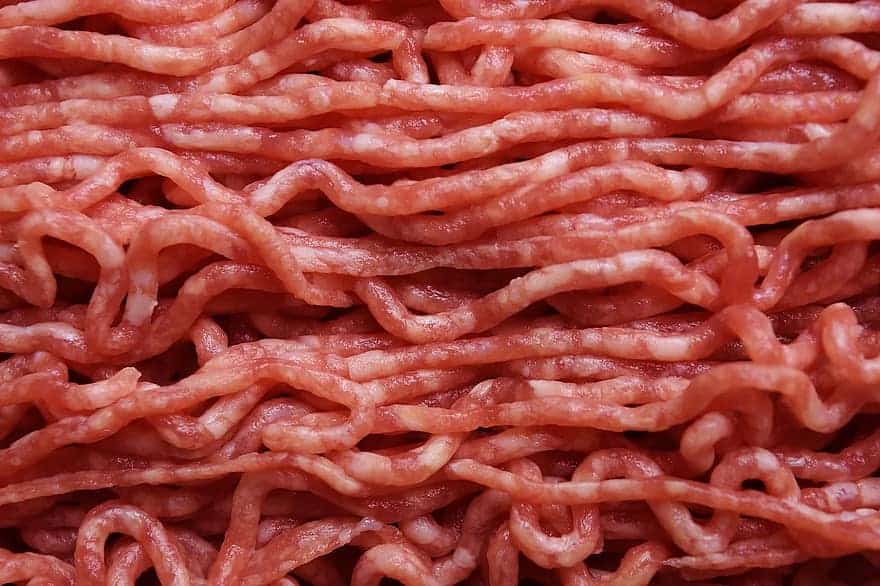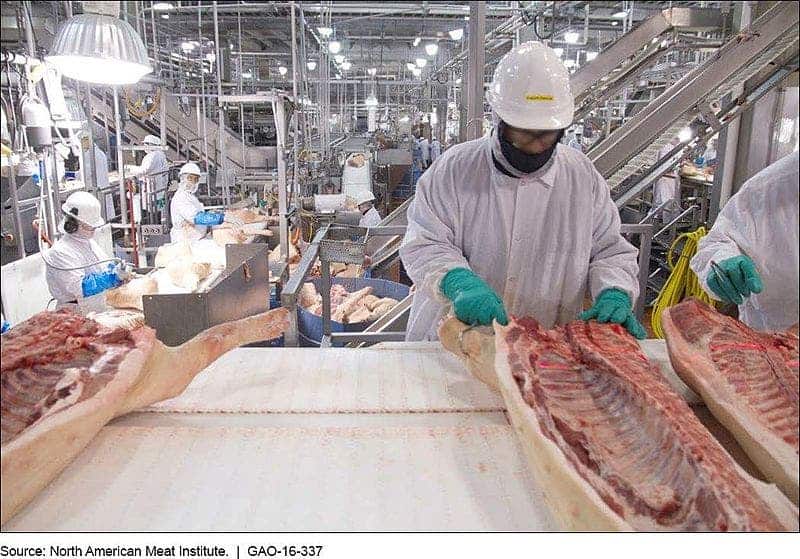Although in small quantities of under 70 grams (2.5 ounces) / day, red meat is not as harmful to your health, consumption of pork is associated with a significant risk of several chronic conditions including diabetes, cardiovascular disease, and several types of cancer.
“I would never recommend eating animal products, and certainly not pork,” says Dana Hunnes, assistant professor at the UCLA Fielding School of Public Health.
The main (but not the only) reason why pork is bad for you is its high content of saturated fats and cholesterol. However, as is often the case with nutrition, the scientific studies are not always clear-cut, and dietary recommendations tend to be laxer than existing evidence.

We eat too much pork
Pigs were domesticated in Mesopotamia, around 15,000 years ago. But up until the 20th century, consumption of pork was relatively low, and often restricted to the autumn-winter part of the year.
In the 20th century, mankind rethought its animal consumption, and industrial farming took over. The world now produces 4 times more meat than 50 years ago — which in 2013, meant 320 million tons of meat. Over 80 billion animals are slaughtered each year for meat, with pig meat being the most popular type of meat globally (although poultry is increasing most rapidly).
The average American consumes 124 kilograms of meat every year, and around 24 of those are pig. Pork (the “food” name of pigs) is consumed in a number of ways, from sausages and bacon to fresh meat and lard.

Pork consumption in the US has remained relatively stable for much of the past century (although chicken, turkey, and beef have increased compared to the early 1900s). But this doesn’t necessarily mean good news.
Virtually all dietary guidelines recommend no more than 500 grams (1.1 pounds) of red meat a week — not just pork. Meanwhile, Americans consume double that, and the numbers keep growing.
It’s not just Americans (although the US is near the top of the list for per capita red meat consumption) — as the world is becoming more affluent, it is consuming more red meat, and pork is a staple in many parts of the world.
Despite some claims from the industry, pork is undoubtedly red meat. In particular, one advertising campaign from the U.S. National Pork Board labeled pork as “the other white meat”. The campaign was highly successful, and at some point, 87% of consumers identified pork with the slogan, although the USDA never considered pork to be anything other than red meat.
“Pork is considered a red meat, and it is high levels of saturated fat, and all of the other animal protein compounds that are deleterious to health. Pork is not a “white meat”, and even if it were, white meat has also been demonstrated to be deleterious to health,” Hunnes told ZME Science.
Is pork bad for you?
In 2012, a large study on over 100,000 individuals found strong evidence that consumption of red meat is linked to a shorter and less healthy life. The evidence was strong, although pork wasn’t analyzed in particular — this is often the case with such studies, they classify all red meat together.
“This study provides clear evidence that regular consumption of red meat, especially processed meat, contributes substantially to premature death,” according to Dr. Frank Hu, one of the senior scientists involved in the study and a professor of nutrition at the Harvard School of Public Health.
It was by no means an isolated study. Studies have highlighted the health risks associated with pork consumption for decades. Sometimes, it’s not always obvious problems — for instance, a 1985 study finding a correlation between pork consumption and cirrhosis. But most of the time, the same health problems pop up. Despite the fact that pork can be a source of nutrients such as protein and iron, it is associated with a number of health problems.
Pork consumption and cancer
In 2015, the International Agency for Research on Cancer concluded that red meat is probably carcinogenic to humans. Several types of cancer have been linked to pork. For instance, a 2011 analysis found that for each additional 100 grams of red meat (either pork or beef) per day, the risk of colorectal cancer increases by 17%. Correlations were also observed for pancreatic and prostate cancer, although the associations were not as strong.
“High intake of red and processed meat is associated with significant increased risk of colorectal, colon and rectal cancers,” the study concluded.
Even moderate intake of pork can increase the cancer risk, another study found. The study, carried out in 2019, found that even red meat consumption in accordance with existing guidelines leads to an increased bowel cancer risk: 20% with each extra slice of ham or rasher of bacon per day. This is particularly significant because it shows that the risk has remained significant even as people’s diets may have changed over the years.

It’s worth noting that all these are big studies — and there’s more. A 2013 meta-analysis (a study of studies) found that gastric cancer risk also increases with red meat consumption, although the authors called for more research to clarify this connection.
A 2016 literature review found that for 100g or more per day of red meat, the risk breast cancer increases by 11%, 17% for colorectal cancer, and 19% for prostate cancer.
Meanwhile, a 2017 review found numerous potential carcinogens in red meat products, including polycyclic aromatic hydrocarbons, and heterocyclic amines
“Red meat products, especially those that have been processed, have a wide variety of carcinogenic molecules known to increase the risk of colorectal cancer,” the study concluded.
It should be noted that this is an increase in relative risk. Let’s take an example.
Let’s say the cancer risk is 10%, and pork consumption causes a 17% increase in the total cancer risk. The net increase in risk is 17% of 10% — so in total, it’s a 1.7% increase that takes the total risk from 10 to 11.7%.
Some use this to claim that the disease risk from red meat is exaggerated. At the end of the day, we all judge risk in our own way, and one may consider the extra risk acceptable — but even a 1% change is huge considering how common these diseases are.
The exact risk is hard to establish, but overall, pork consumption seems to be linked with higher cancer risk. There is “sufficient evidence” to draw a link between the consumption of processed meat products and cancer, WHO experts also conclude.
Pork consumption and obesity
It’s no secret that the world (and especially the developed world) is facing an obesity crisis. Decades ago, the culprit was considered to be fat, whereas in more recent years, sugar has also emerged as a major issue. However, according to a recent study, meat is also to blame.
“In the analysis of obesity prevalence across 170 countries, we have found that sugar availability in a nation explains 50% of obesity variation while meat availability another 50%. After correcting for differences in nations’ wealth (Gross Domestic Product), calorie consumption, levels of urbanization and of physical inactivity, which are all major contributors to obesity, sugar availability remained an important factor, contributing independently 13%, while meat contributed another 13% to obesity,” said Professor Maciej Henneberg, head of the Biological Anthropology and Comparative Anatomy Research Unit, and one of the study authors.
Again, the effect of individual meats was not calculated, but overall, high meat availability was found to be correlated with obesity. It’s also worth noting that it’s not necessarily the fat, but also the protein in the meat that contributes to obesity.
According to another 2014 review of studies covering a combined total over 1 million participants, “red and processed meat intake is directly associated with risk of obesity, and higher BMI.”
The key to understanding these nutritional studies is to look at the big picture. You will always find differences between individual studies, and you can find studies that support varying viewpoints.
If you want to have a better understanding of this process, it’s best to look at large-scale studies and reviews of studies.
The fact that many diet-and-disease studies lump pork together with other types of red meat also dilutes the association related to pork alone.
According to the Global Burden of Disease study 4.7 million people died prematurely in 2017 as a result of obesity. Obesity is one of the most important health risk factors. According to recent estimates
Pork consumption and the link to diabetes and cardiovascular disease
This is where things are not as clear as before. Because red meat consumption is associated with increased weight, and increased weight is associated with diabetes and cardiovascular disease, it’s doubly difficult to assess which risks are caused directly by meat, and which by increased weight. This is why studies in this regard are often inconclusive and hard to interpret.
Even so, the prevailing evidence seems to show negative effects of red meat consumption.
A 2011 study on over 100,000 participants found that “red meat consumption, particularly processed red meat, is associated with an increased risk of type 2 diabetes.” Substituting one serving of red meat per day with nuts, low-fat dairy and whole grains reduces the risk of type 2 diabetes by up to 35%. Another study, one year earlier, concluded that a “reduction of the consumption of processed meat may help prevent the global epidemic of type 2 diabetes”.
A review of almost half a million people found a positive link between red meat consumption and cardiovascular disease and overall mortality. Eating red meat daily triples the levels of a heart disease-related chemical called TMAO.
“These findings reinforce current dietary recommendations that encourage all ages to follow a heart-healthy eating plan that limits red meat,” says nutrition researcher Dr. Charlotte Pratt, the NHLBI project officer for the study. “This means eating a variety of foods, including more vegetables, fruits, whole grains, low-fat dairy foods, and plant-based protein sources such as beans and peas.”

Another recent study has found that eating two servings of red meat per week was linked to a 7% higher risk of heart and circulatory diseases, compared to eating none at all (again, this is relative risk).
However, another study concluded that eating meat within the recommended quantity does not increase cardiovascular risk, and recent studies have called for more studies on this issue.
A part of the reason why nutritional studies are so hard to reconcile is that they often rely on self-reported questionnaires. Humans are notoriously unreliable when it comes to self-reporting and often tend to distort the data.
This is why it’s important to look at results from multiple angles, and when possible, also try to find the mechanism producing the observed effect.
Another important aspect is how the meat is prepared: is it processed, and if yes, how? Is it cooked at high temperatures? All this can matter. As a rule of thumb, the more it is processed and cooked, the worse it is. This is particularly concerning since pork is often consumed in processed form (in products such as bacon or sausages), which seem to have an even higher health risk.
Other health risks associated with pork consumption: liver disease, MS, yersinia
Some of the health issues associated with pork consumption tend to fly under the radar.
For instance, the link between pork and multiple sclerosis (MS) is known at least since the 1980s, and has been demonstrated across dozens of countries. The link has been supported by multiple studies carried in various environments. It’s more than just an observation: between 2007 and 2009, a cluster of 24 pork plant workers fell mysteriously ill with a disease that triggers MS-like symptoms — a problem which was ultimately traced back to pork.
Remember the 1985 cirrhosis study we mentioned at the start of the article? Surprisingly, pork can also cause liver disease, including cirrhosis and liver cancer. Alcohol is of course a main driver here, but pig meat has been repeatedly proven to play a role in both liver cancer and cirrhosis.
Yersinia is another potential risk factor that is often overlooked. In pork that isn’t properly cooked, the Yersinia bacteria can creep in, causing severe symptoms and even contributing to mortality. In the US alone, yersinia kills 35 people and causes 117,000 cases of food poisoning each year. Its main point of access inside the human body? You’ve guessed it — pork. The problem can be averted by properly cooking the meat.
Can pork ever be good for you?

Every once in a while, you end up seeing a “pork isn’t bad for you” study picked up by the media. Recently, one such study published in late 2019 made all the rounds. “Red meat is back on the menu” and “Stop worrying about red meat” were just some of the headlines flown around, validating what meat lovers all around the world wanted to hear. But there’s a problem — several, actually.
This was just one study, the authors themselves admitted low-quality evidence, and the study was called into question in more ways than one (see our detailed analysis of that study here).
A Professor of Medicine and Human Nutrition at University of Otago, New Zealand, summed up the general feeling among scientists:
“In my opinion, the weak recommendation based on low-certainty evidence that adults continue current consumption of unprocessed red meat and processed meat is potentially unhelpful and could be misleading.”
This doesn’t mean that the study is meaningless or that we should immediately disregard conflicting evidence — but neither should we overturn decades of research because a conflicting study came out. This just means that we shouldn’t jump on the next study that gets picked up by the media. Instead, looking at multiple, large studies can offer a much more accurate image.
It can be daunting to look through studies when all you want is to know whether bacon is alright, so if you want to boil it down to a simple tidbit, it’s hard to see pork as part of a healthy diet.
“All animal proteins, exclusive of what animal they come from, can be harmful to health, especially if and when they are processed. So I would never recommend eating animal products, and certainly not pork,” says Hunnes.
This being said, if your diet is low in salts, saturated fats and you have an active lifestyle, you can incorporate low amounts of lean, preferably unprocessed pork into your diet, and will still have a relatively low risk of developing chronic diseases.
There are many things we don’t fully understand about nutrition, but what we do know is that the total matters more than the sum of the parts. Some things are healthier than others, and it’s important to be careful with all aspects of your lifestyle.
However as Havard researchers have pointed out, even the dietary guidelines sometimes don’t take into consideration the risks that their very own analyses highlight.
But don’t you need red meat for protein?
As mentioned, pork can contain large amounts of protein, but the idea that you need to eat red meat to get your protein is a myth.
“We need nutrients, and we need amino acids that come from protein, but neither of these do we need from animal proteins,” Hunne explains.
Replacing red meat with plant protein has been found to increase longevity and improve overall health in a number of studies. While people who don’t eat much meat (or don’t eat meat at all) need to pay some attention to complementing their protein and vitamin intake, diets focused on plant rather than animal protein tend to be associated with better health outcomes.

In 2006, a study compared plant with animal protein, concluding that “with a proper combination of sources, vegetable proteins may provide similar benefits as protein from animal sources.”
Results of a 2016 meta-analysis found that plant-based protein is associated with a lower risk of disease of all-cause mortality, and cardiovascular problems — a link that was especially prevalent for people who have at least one health risk factor.
“Substitution of plant protein for animal protein, especially that from processed red meat, was associated with lower mortality, suggesting the importance of protein source.”
The bottom line
Consumption of meat, in any quantity, can be detrimental to your health in a number of ways, and generally speaking, the more you eat, the more you increase your risk.
Not all pork is made equal. Uncooked meat can carry pathogens, while processed meat tends to be worse. Meat that is high in saturated fats and trans fats causes the greatest risk to health.
Multiple conditions have been associated with pork consumption, including but not limited to diabetes, MS, cardiovascular disease, obesity, cirrhosis, and multiple types of cancer. The exact nature of this risk is still a matter of active research, but if you want to be on the safe side, no amount of pork is safe. If you just can’t give it up, the common recommendation is to not go over 500 g (1.1 pounds) per week and stick to lean, unprocessed meat.
Substituting red meat protein with plant protein is linked to a longer, healthier life, with multiple studies backing this up. Reducing pork consumption can also have a positive environmental impact, reducing the greenhouse gas emissions and water consumption associated with our food. Ethically, slaughtering billions of animals every year (especially animals as — or even more — intelligent than dogs) is not the right thing to do.
Oh, and there’s another reason why avoiding pork might be wise, Hunnes notes.
“In the past couple of decades, a couple of disease epidemics (swine flus) have emerged from pigs. Just another reason not to raise animals in confinement.
In short, I do not recommend eating pork. Under any circumstances,” she concludes.


